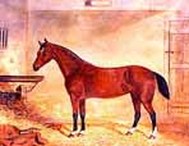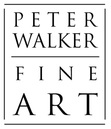S.S Knights

Samuel Knights, an Australian Colonial Sporting Artist who painted in the Woodhouse vein, is first mentioned in contemporary literature in Australian Horse Racing (1971) where one of his works was reproduced. Further reference can be found in the catalogue to the exhibition of Australian Sporting Art, Pastures and Pastimes, curated by Dr. C. Laverty in 1983. Only recently has in depth research into the artist begun and much still remains unsolved in regards the history of S. S. Knights and his works. His name in official documents and newspapers of the time is variably spelt with and without the final "s" of his surname.
Samuel Knights was born in London circa 1814 and arrived in the colony of Victoria circa 1852, aged 38. All his known works are from his Australian period. His fathers name was Samuel Salkeld Knights and it is assumed that the artists second name was Salkeld too, as he signed his works S.S.Knights, although the second name does not appear on his Death Certificate. Records indicate his father probably was the publisher S. Knights who is known to have had premises at Royal Exchange, London early last century and to have published sporting prints (Siltzer,P.341).
All of Knights' known paintings are oils on canvas and of a "sporting" nature with his earliest known work being of a pair of horses dated 1856. In 1857 he exhibited paintings at the Geelong Mechanics Institute Exhibition with nine being of horses, two of cattle, one of a white hawk and a few of a more general nature.
In 1865 Samuel married Selina Wild and they were probably living in Carlton in 1866-67 until first moving to Balmain Street and then Dover Street, Richmond. Samuel was listed at this address as an artist in Trade Directories of the time and was to live there until his death on 10 May 1880, aged 66. Selina continued to live at this address for some years.
In 1876 S. S. Knights is mentioned in the Adelaide Observer (4 November,23 December) as having visited and exhibited works in that Colony.
Only ten or so of the artists works are known, with dated and signed examples of the period 1856 to 1876 existing. Interestingly, approximately half of these known works are in a collection that has been passed down by descent from the original owner of the animals depicted. The State Libraryof Victoria has a large painting of the start of The Melbourne Cup of 1865 in its collection.
Most of Samuel Knight's paintings are signed S. S. Knights and dated. They are usually of animals in natural outdoor settings, although there exists an example of a horse in a stall. Practically all take the form of "animal portraits". His paintings of bulls are typical of the large out-sized English School animal portraits of the first half of the nineteenth century while his horse paintings are generally well executed, demonstrating a fair knowledge of horse anatomy, although some do have "problems" with proportion of certain body parts (eg. the head appearing too small in comparison to the body in a few cases). The backgrounds do not show any "typical" Australian bush but often include post-and-rail fences and tree's. A yellow to green hue presents itself when observing the grassed areas found in most of Knights' paintings. The artists initial canvas preparation varied from very thorough to practically no preparation at all. Plates One and Two are paintings of a horse and bull that are typical of S. S. Knights oeuvre.
Fortunately, in regards the identity of the animals painted and that oftheir original owners, many of the known works by Knights have been able to be traced which increases the historical value significantly.
In the relatively unstudied field of Australian Sporting Artists little is known of Samuel Knights. Undoubtedly increased recognition of this artist will come with the realization of the importance of his works both as early examples of Australian Sporting Art and as historically important paintings themselves, depicting events and animals important in their own right in developing the colonial communities of the time.
Bibliography
Adelaide Observer, 4/11/1876, 23/12/1876.
Australian Horse Racing, 1971, p.46.
Geelong Mechanics Institute Exhibition Catalogue, 1857.
Laverty, C.. Pastures and Pastimes.Exhibition Catalogue.Victorian Ministry
of the Arts, Gardner Printing Com., Vic. 1983.
Siltzer, F.. The Story of British Sporting Prints. Hutchinson and Comp.,
Lond., no publication date.
Samuel Knights was born in London circa 1814 and arrived in the colony of Victoria circa 1852, aged 38. All his known works are from his Australian period. His fathers name was Samuel Salkeld Knights and it is assumed that the artists second name was Salkeld too, as he signed his works S.S.Knights, although the second name does not appear on his Death Certificate. Records indicate his father probably was the publisher S. Knights who is known to have had premises at Royal Exchange, London early last century and to have published sporting prints (Siltzer,P.341).
All of Knights' known paintings are oils on canvas and of a "sporting" nature with his earliest known work being of a pair of horses dated 1856. In 1857 he exhibited paintings at the Geelong Mechanics Institute Exhibition with nine being of horses, two of cattle, one of a white hawk and a few of a more general nature.
In 1865 Samuel married Selina Wild and they were probably living in Carlton in 1866-67 until first moving to Balmain Street and then Dover Street, Richmond. Samuel was listed at this address as an artist in Trade Directories of the time and was to live there until his death on 10 May 1880, aged 66. Selina continued to live at this address for some years.
In 1876 S. S. Knights is mentioned in the Adelaide Observer (4 November,23 December) as having visited and exhibited works in that Colony.
Only ten or so of the artists works are known, with dated and signed examples of the period 1856 to 1876 existing. Interestingly, approximately half of these known works are in a collection that has been passed down by descent from the original owner of the animals depicted. The State Libraryof Victoria has a large painting of the start of The Melbourne Cup of 1865 in its collection.
Most of Samuel Knight's paintings are signed S. S. Knights and dated. They are usually of animals in natural outdoor settings, although there exists an example of a horse in a stall. Practically all take the form of "animal portraits". His paintings of bulls are typical of the large out-sized English School animal portraits of the first half of the nineteenth century while his horse paintings are generally well executed, demonstrating a fair knowledge of horse anatomy, although some do have "problems" with proportion of certain body parts (eg. the head appearing too small in comparison to the body in a few cases). The backgrounds do not show any "typical" Australian bush but often include post-and-rail fences and tree's. A yellow to green hue presents itself when observing the grassed areas found in most of Knights' paintings. The artists initial canvas preparation varied from very thorough to practically no preparation at all. Plates One and Two are paintings of a horse and bull that are typical of S. S. Knights oeuvre.
Fortunately, in regards the identity of the animals painted and that oftheir original owners, many of the known works by Knights have been able to be traced which increases the historical value significantly.
In the relatively unstudied field of Australian Sporting Artists little is known of Samuel Knights. Undoubtedly increased recognition of this artist will come with the realization of the importance of his works both as early examples of Australian Sporting Art and as historically important paintings themselves, depicting events and animals important in their own right in developing the colonial communities of the time.
Bibliography
Adelaide Observer, 4/11/1876, 23/12/1876.
Australian Horse Racing, 1971, p.46.
Geelong Mechanics Institute Exhibition Catalogue, 1857.
Laverty, C.. Pastures and Pastimes.Exhibition Catalogue.Victorian Ministry
of the Arts, Gardner Printing Com., Vic. 1983.
Siltzer, F.. The Story of British Sporting Prints. Hutchinson and Comp.,
Lond., no publication date.



